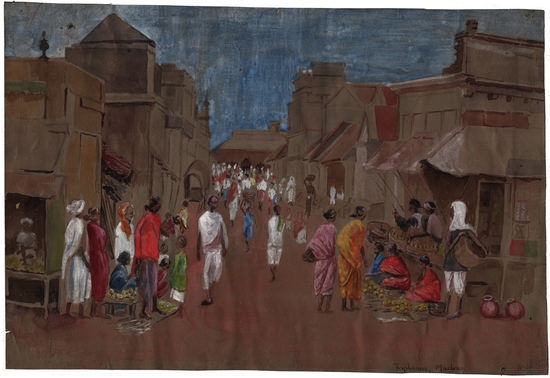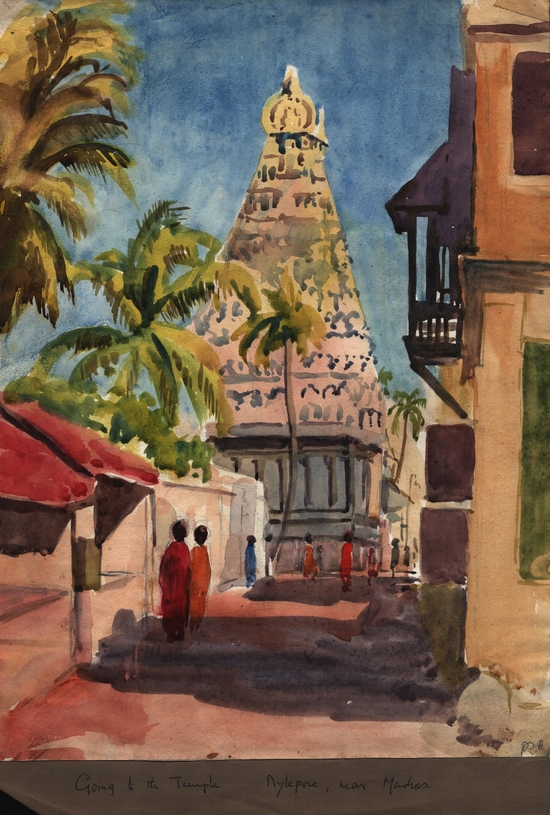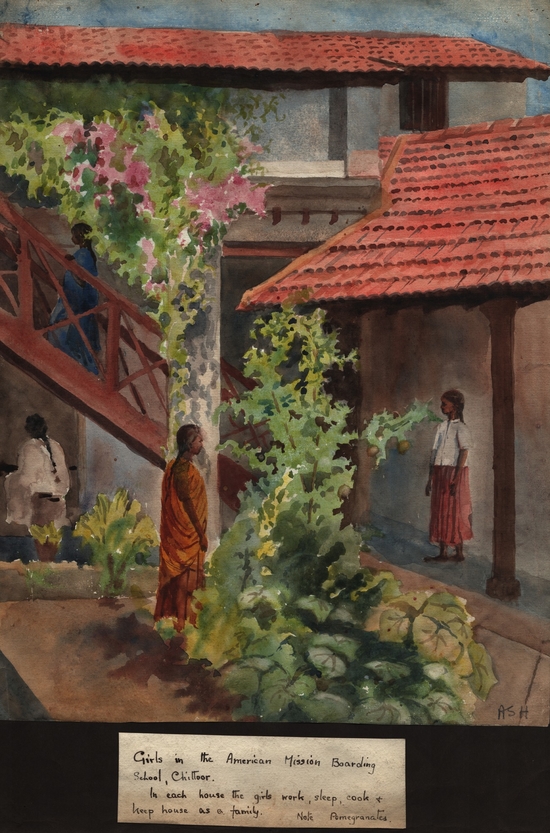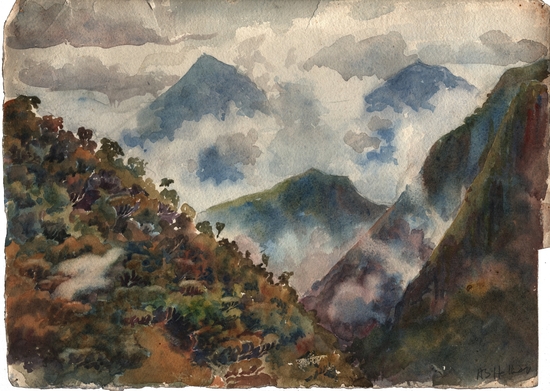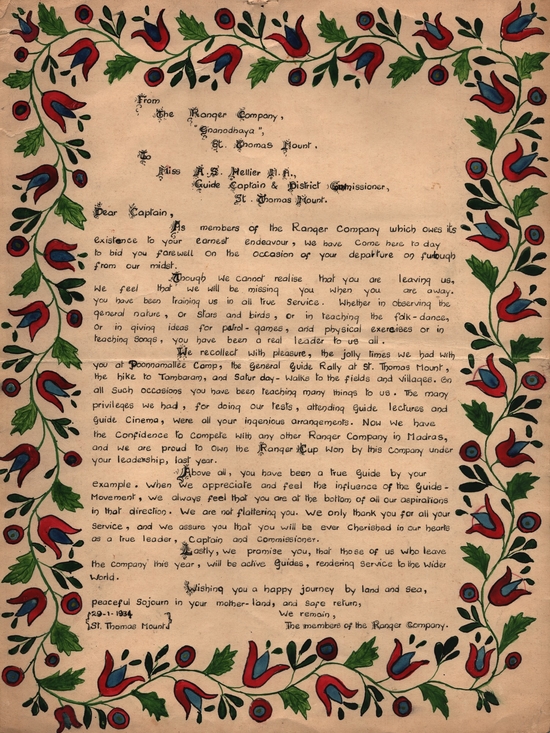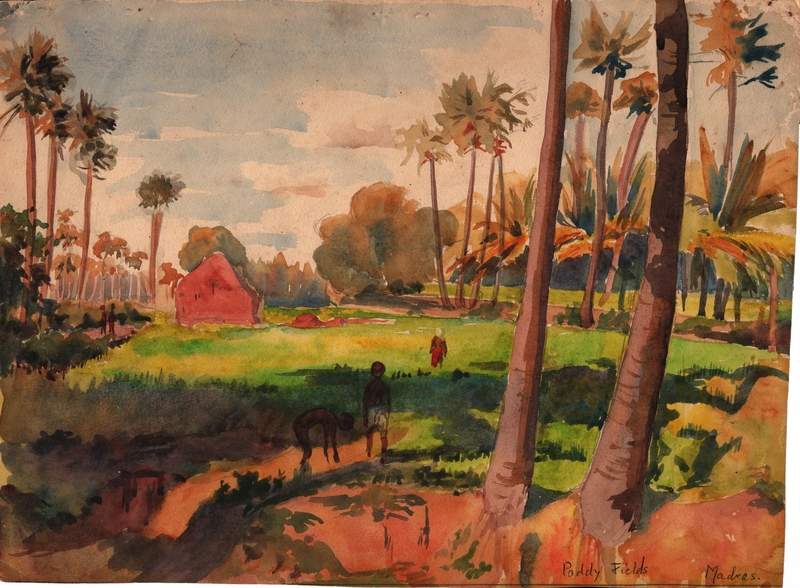“I am here to save you. I am your mother.” (Amy Carmichael)
Agatha Gay Hellier was the granddaughter of Benjamin Hellier, a theological teacher who wrote and gave lectures on Methodist teachings. At the age of twenty-six, she travelled to South India as a Methodist missionary where she focused on teaching in schools and working in hospitals. This exhibition demonstrates the impact of female missionaries through Hellier’s artwork and the scenes she would have witnessed, whilst leading us to understand interactions between Christianity and India’s indigenous faiths.
We are grateful to Third Year History of Art students at Oxford Brookes University for creating this exhibition as part of their 'Curatorial Practice' module.
Indian Christianity
British Christians have been venturing to India with the intention of proselytising since the seventeenth century when the East India Company aimed to spread the message of the gospel in the settlements they had made. With India’s constantly increasing population, among them over 240 million Hindus, missionaries understood it to be their duty to convert as many people to Christianity as possible. It was not an easy endeavour, and at the beginning of the twentieth century there were only one million Christians within India. Many Christian missionaries dedicated themselves to missionary work and spent the majority of their lives abroad, spreading the word of the Gospel. Agatha Gay Hellier (1897-1980) was one of them.
Working as a missionary for over thirty years, painting and sketching along the way, this exhibition provides a commentary on the life of a female missionary in India through her works and highlights the importance of women in delivering the Church’s message. Her works allowed Methodists to see how God was using their ambassadors and partners around the world. By looking at her watercolours we can further understand the integration of western education into India’s religious heritage and education system, as well as the relationship and interaction between Christian missionaries and native Indian religions.
The Church of South India (CSI) was established on the 27 September, 1941 in order to unite its clusters of ministries across churches in South India. At the beginning of the twentieth century around 1 million of the 277 million people practising Hinduism and Islam were surrounded by Christian influence across India. By 1947, the year India gained independence, the CSI had converted nearly another 1 million members. Most of the CSI’s converts came from villages of famine and squalor, as parents saw the Church as a source of refuge for their children. Education and medical care were almost non-existent for the very poor. Being baptised meant their children could attend mission schools, where they were taught about the morals of the Church.
Triplicane, Madras
The bustling market shown here is located in Triplicane, one of the oldest parts of Madras. Madras was a port city which was used for trade and tourism, where Hellier’s missionary life possibly began. The foreground of Hellier's painting is very detailed and shows people busily shopping, demonstrating the lifestyle and communities in the densely populated cities of India.
Agatha Gay Hellier (1897–1980)
Watercolour on paper
H 27.1 x W 34.7 cm
The Oxford Centre for Methodism and Church History
Going to the Temple, Mylapore, near Madras
The Hindu temple, Kapaleeshwarar in Madras, stands at the centre of this picture calling the people to worship. Despite the presence of Christian missionaries in the city, the majority of Madras’s population was still Hindu. This would have been a scene that Hellier witnessed constantly as the citizens of Mylapore made their way to prayer.
Agatha Gay Hellier (1897–1980)
Watercolour on paper
H 41.2 x W 29.2 cm
The Oxford Centre for Methodism and Church History
Women Missionaries
Most missionaries were under the direction of male church leaders, but male missionaries were discouraged from approaching Indian women about the Gospel or healthcare, leaving women to run hospitals and schools. This meant they had to be intellectual, moral, and sociable. Up until the 1960s, most of the women’s work was done on foot or by travelling on public transport, whereas men were provided with cars; just one insight into the gender issues surrounding missionary work. However, women’s missionary work glorified the image of motherhood: “I am here to save you. I am your mother,” said Amy Carmichael. The work done by Methodists such as Hellier and Carmichael was pertinent to the success of the Church in India.
Girls in the American Mission Boarding School, Chittor
Run by female missionaries, the boarding schools were spaces that combined the Hindu custom of communal and group living with lessons that taught Christian principles. The school courtyard represents the importance of nature within the school curriculum. Below the painting, Hellier simply notes ‘pomegranates’ which perhaps refers to the fruit growing on the vine which also has Christian connotations of sanctity.
Agatha Gay Hellier (1897–1980)
Watercolour on paper
H 35.5 x W 27 cm
The Oxford Centre for Methodism and Church History
On Trek in the Pulnai Hills
This painting shows the towering mountains of the landscape, which demonstrates the missionary’s connection with God and the earth He has created. Hellier uses a natural colour palette to accentuate this further. The use of aerial perspective further highlights the imposing nature of the landscape. This may have been a view that Hellier witnessed whilst travelling on foot to a remote village to continue her mission.
Agatha Gay Hellier (1897–1980)
Watercolour on paper
H 29 x W 34 cm
The Oxford Centre for Methodism and Church History
Illustrated Letter
Leaving her post as the Principal of the newly established Elementary Teacher Training School in Gnanodhaya, St Thomas Mount, this letter is a heartfelt farewell from the Ranger Company to Hellier.
Thanking her for being a ‘true Guide’ the letter educates us about the duties Hellier undertook, and the lessons she taught to the members of The Ranger Company. They would have learnt about the Christian message and practical skills.
Agatha Gay Hellier (1897–1980)
Ink & watercolour on paper
H 38.5 x W 28.7 cm
The Oxford Centre for Methodism and Church History
